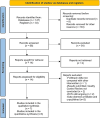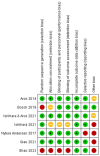Efficacy and safety of follitropin delta for ovarian stimulation in vitro fertilization/ intracytoplasmic sperm injection cycles: a systematic review with meta-analysis
- PMID: 38486276
- PMCID: PMC10938807
- DOI: 10.1186/s13048-024-01372-w
Efficacy and safety of follitropin delta for ovarian stimulation in vitro fertilization/ intracytoplasmic sperm injection cycles: a systematic review with meta-analysis
Abstract
Background: Follitropin delta is a novel recombinant follicle stimulating hormone preparation uniquely expressed in a human fetal retinal cell line by recombinant DNA technology. To date, no systematic review was available about the safety and the efficacy of the follitropin delta. The objective of this study was systematically reviewing the available literature and to provide updated evidence regarding the efficacy-safety profile of follitropin delta when compared to other gonadotropin formulations for ovarian stimulation in in vitro fertilization (IVF) and intracytoplasmic sperm injection (ICSI) cycles.
Methods: An extensive search was performed to identify phase 1, phase 2 and phase 3 RCTs in humans focused on follitropin delta use for ovarian stimulation in IVF/ICSI cycles. The risk of bias and the overall quality of the evidence was analyzed. All data were extracted and analyzed using the intention-to-treat principle and expressed per woman randomized.
Results: A total of 7 RCTs (1 phase 1 RCT, 2 phase 2 RCTs and 4 phase 3 RCTs) were included in the qualitative analysis, whereas data of three phase 3 RCTs were meta-analyzed. All trials compared personalized recombinant follitropin delta treatment versus conventional recombinant follitropin alfa/beta administration in potentially normo-responder patients who receive ovarian stimulation in GnRH antagonist IVF/ICSI cycles. No difference between two regimens was detected for clinical pregnancy rate [odds ratio (OR) 1.06; 95% confidence intervals (CI): 0.90, 1.24; P = 0.49; I2 = 26%], ongoing pregnancy rate (OR 1.15; 95%CI: 0.90, 1.46; P = 0.27; I2 = 40%), and live birth rate (OR 1.18; 95%CI: 0.89, 1.55; P = 0.25; I2 = 55%). No data were available regarding cumulative success rates. The rate of adoption of strategies to prevent ovarian hyperstimulation syndrome (OHSS) development (OR 0.45; 95%CI: 0.30, 0.66; P < 0.0001; I2 = 0%), and the rate of both early OHSS (OR 0.62; 95%CI: 0.43, 0.88; P = 0.008; I2 = 0%) and all forms of OHSS (OR 0.61; 95%CI: 0.44, 0.84; P = 0.003; I2 = 0%) were significantly lower in the group of patients treated with personalized follitropin delta treatment compared to those treated with conventional follitropin alfa/beta administration.
Conclusion: Personalized follitropin delta treatment is associated with a lower risk of OHSS compared to conventional follitropin alfa/beta administration in potentially normo-responder patients who receive ovarian stimulation in GnRH antagonist IVF/ICSI cycles. The absence of cumulative data does not allow definitive conclusions to be drawn regarding the comparison of the effectiveness of the two treatments.
Protocol study registration: CRD42023470352 (available at http://www.crd.york.ac.uk/PROSPERO ).
Keywords: Follitropin delta; Gonadotropin; IVF; Infertility; Ovarian stimulation; Sterility.
© 2024. The Author(s).
Conflict of interest statement
SP, DC, PELS, and AB have no conflict of interest to declare.
Figures



Similar articles
-
Recombinant luteinizing hormone (rLH) and recombinant follicle stimulating hormone (rFSH) for ovarian stimulation in IVF/ICSI cycles.Cochrane Database Syst Rev. 2017 May 24;5(5):CD005070. doi: 10.1002/14651858.CD005070.pub3. Cochrane Database Syst Rev. 2017. PMID: 28537052 Free PMC article.
-
Gonadotropin-releasing hormone agonist versus HCG for oocyte triggering in antagonist-assisted reproductive technology.Cochrane Database Syst Rev. 2014 Oct 31;2014(10):CD008046. doi: 10.1002/14651858.CD008046.pub4. Cochrane Database Syst Rev. 2014. PMID: 25358904 Free PMC article.
-
Biosimilars versus the originator of follitropin alfa for ovarian stimulation in ART: a systematic review and meta-analysis.Hum Reprod. 2025 Feb 1;40(2):343-359. doi: 10.1093/humrep/deae274. Hum Reprod. 2025. PMID: 39719046 Free PMC article.
-
Oral medications including clomiphene citrate or aromatase inhibitors with gonadotropins for controlled ovarian stimulation in women undergoing in vitro fertilisation.Cochrane Database Syst Rev. 2017 Nov 2;11(11):CD008528. doi: 10.1002/14651858.CD008528.pub3. Cochrane Database Syst Rev. 2017. PMID: 29096046 Free PMC article.
-
Volume expanders for the prevention of ovarian hyperstimulation syndrome.Cochrane Database Syst Rev. 2016 Aug 31;2016(8):CD001302. doi: 10.1002/14651858.CD001302.pub3. Cochrane Database Syst Rev. 2016. PMID: 27577848 Free PMC article.
Cited by
-
Comparison of Assisted Reproductive Technology (ART) Outcomes in Two Controlled Ovarian Stimulation Protocols Using Follitropin Delta, a Recombinant Follicle-Stimulating Hormone (rFSH) Injection.Cureus. 2025 Mar 27;17(3):e81281. doi: 10.7759/cureus.81281. eCollection 2025 Mar. Cureus. 2025. PMID: 40291328 Free PMC article.
-
Diagnosis and management of infertility in patients with polycystic ovary syndrome (PCOS): guidelines from the Italian Society of Human Reproduction (SIRU) and the Italian Centers for the Study and Conservation of Eggs and Sperm (CECOS Italy).Reprod Biol Endocrinol. 2025 Mar 8;23(1):37. doi: 10.1186/s12958-025-01372-5. Reprod Biol Endocrinol. 2025. PMID: 40055752 Free PMC article.
-
Evaluation of Assisted Reproductive Technology Outcomes Using Crossover Administration of Two Recombinant Follicle-Stimulating Hormones in the Same Patients.Cureus. 2025 Jun 3;17(6):e85312. doi: 10.7759/cureus.85312. eCollection 2025 Jun. Cureus. 2025. PMID: 40621316 Free PMC article.
-
Ovarian Responses and Outcomes of In Vitro Fertilization Following Progesterone-Primed Ovarian Stimulation and Gonadotropin-Releasing Hormone (GnRH) Antagonist Protocols Using Follitropin Delta.Cureus. 2025 Jun 4;17(6):e85341. doi: 10.7759/cureus.85341. eCollection 2025 Jun. Cureus. 2025. PMID: 40469889 Free PMC article.
-
Follitropin Alpha versus Follitropin Beta in IVF/ICSI Cycle: A Retrospective Cohort Study.Drug Des Devel Ther. 2024 Sep 26;18:4359-4369. doi: 10.2147/DDDT.S479700. eCollection 2024. Drug Des Devel Ther. 2024. PMID: 39350950 Free PMC article.
References
-
- European IVF, Monitoring Consortium (EIM), for the European Society of Human Reproduction and Embryology (ESHRE), Wyns C, De Geyter C, Calhaz-Jorge C, Kupka MS, Motrenko T, Smeenk J, Bergh C, Tandler-Schneider A, Rugescu IA. Goossens V. ART in Europe, 2018: results generated from European registries by ESHRE. Hum Reprod Open. 2022; 2022:hoac022. 10.1093/hropen/hoac022. - PMC - PubMed
Publication types
MeSH terms
Substances
LinkOut - more resources
Full Text Sources

